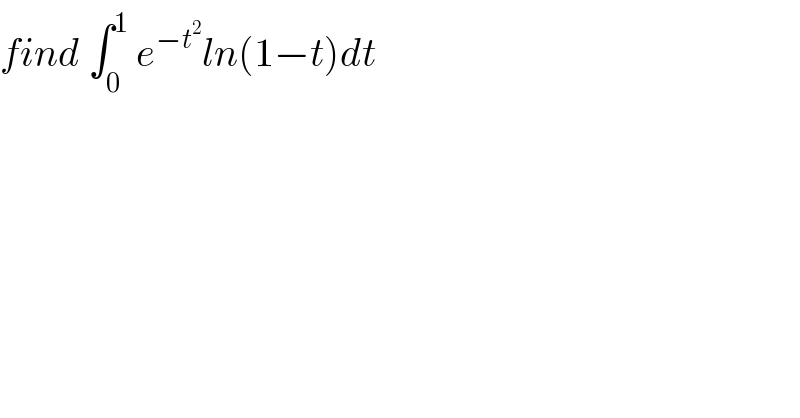
Question and Answers Forum
Previous in Relation and Functions Next in Relation and Functions
Question Number 73396 by mathmax by abdo last updated on 11/Nov/19

Commented by mathmax by abdo last updated on 14/Nov/19
![let take a try let I =∫_0 ^1 e^(−t^2 ) ln(1−t)dt we have ln^′ (1−t) =((−1)/(1−t)) =−Σ_(n=0) ^∞ t^n for ∣t∣<1 ⇒ ln(1−t) =−Σ_(n=0) ^∞ (t^(n+1) /(n+1)) +c (c=0) =−Σ_(n=1) ^∞ (t^n /n) ⇒I =−∫_0 ^1 e^(−t^2 ) (Σ_(n=1) ^∞ (t^n /n))dt =−Σ_(n=1) ^∞ (1/n)∫_0 ^1 t^n e^(−t^2 ) dt =−Σ_(n=1) ^∞ (W_n /n) with W_n =∫_0 ^1 t^n e^(−t^2 ) dt by parts u^′ =t^n and v=e^(−t^2 ) ⇒ W_n =[(1/(n+1))t^(n+1) e^(−t^2 ) ]_0 ^1 −∫_0 ^1 (1/(n+1))t^(n+1) (−2t)e^(−t^2 ) dt =(e^(−1) /(n+1)) +(2/(n+1)) ∫_0 ^1 t^(n+2) e^(−t^2 ) dt =(e^(−1) /(n+1)) +(2/(n+1)) W_(n+2) ⇒ (n+1)W_n =e^(−1) +2 W_(n+2) ⇒W_(n+2) =(1/2){ (n+1)W_n −e^(−1) } ....be continued....](Q73699.png)
Answered by mind is power last updated on 11/Nov/19

